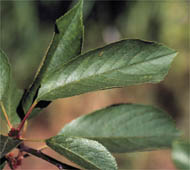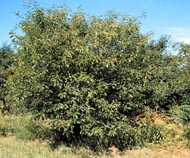Sweet Cherry (Mazzard Cherry, European Cherry)

Leaf Characteristics
- broad, flat leaves
- simple leaves
- not lobed
- fine, double teeth
- all teeth same size
- shorter stem
- all side veins same length
- leaves long, not narrow
- veins curved
- less than 5" long
- stem less than 1/3 length of leaf
- short tip, veins not dense
- oval
- downy

Fruit Characteristics
- other fruit (not cone, winged, acorn, or in pod or capsule)
- without husk or capsules
- loose, not packed tightly together
- fruit with pit
- whole fruit less than 1 inch
- fruit without strap-like modified leaf
- not like rasperries
- fruit not at end of single stalk
- loosely clustered
- various colors but leaves not modified
- round, dark red to black
- 1" in diameter
The Sweet Cherry is a larger tree than either the Common Chokecherry or the Flowering Cherry. The smooth, reddish-brown bark often peels off in horizontal strips on older trees. The Sour Cherry (Prunus cerasus), a native of Europe, is a somewhat smaller tree and in the U.S. it is less common than the Sweet Cherry in the wild state. Bark of the Sweet Cherry is gray and scaly, and it becomes rough on older trees. The Sweet Cherry is native to Europe and western Asia and has been cultivated since ancient times. It was introduced into North America in the early 1600s. Since then, cultivators of trees have developed many horticultural forms. Today, in addition to being planted for its fruit, one sometimes finds it growing wild along roadsides, in thickets and in second-growth woodlands. Workers in Europe often use wood from the Sweet Cherry for interior finish and for making furniture. Birds like the fruit of this tree. They are chiefly responsible for spreading it outside of cultivated areas.
 Tree Size
height 50' - 75'
diameter 2' to 3'
Tree Size
height 50' - 75'
diameter 2' to 3'
 Bark
Bark 